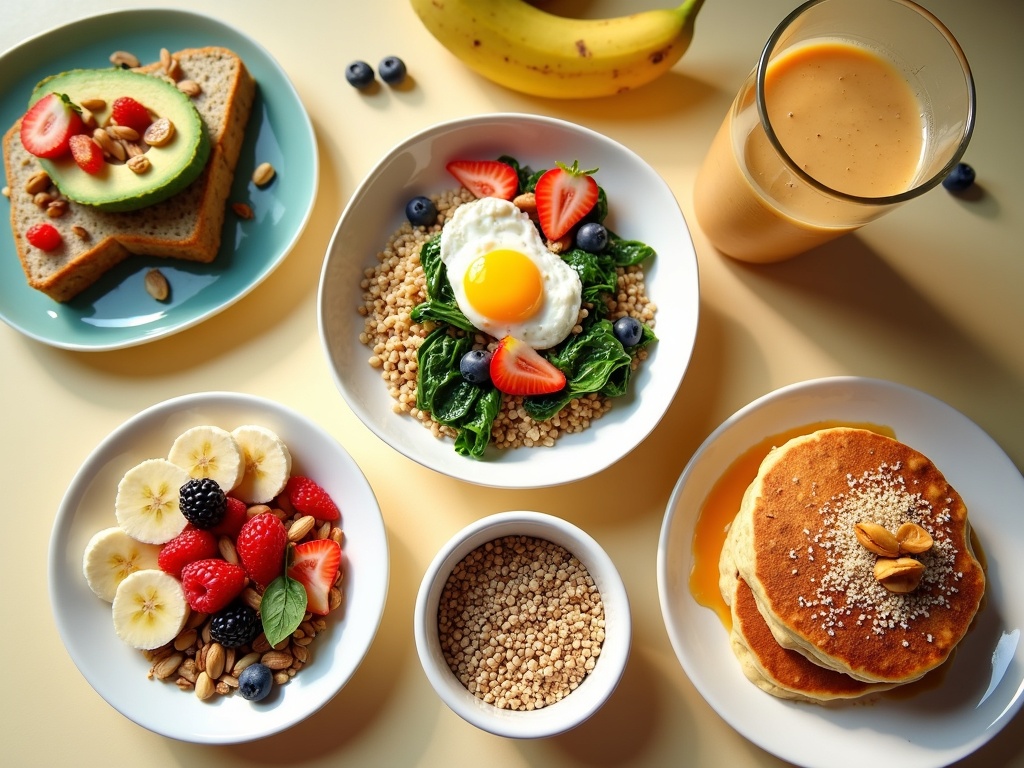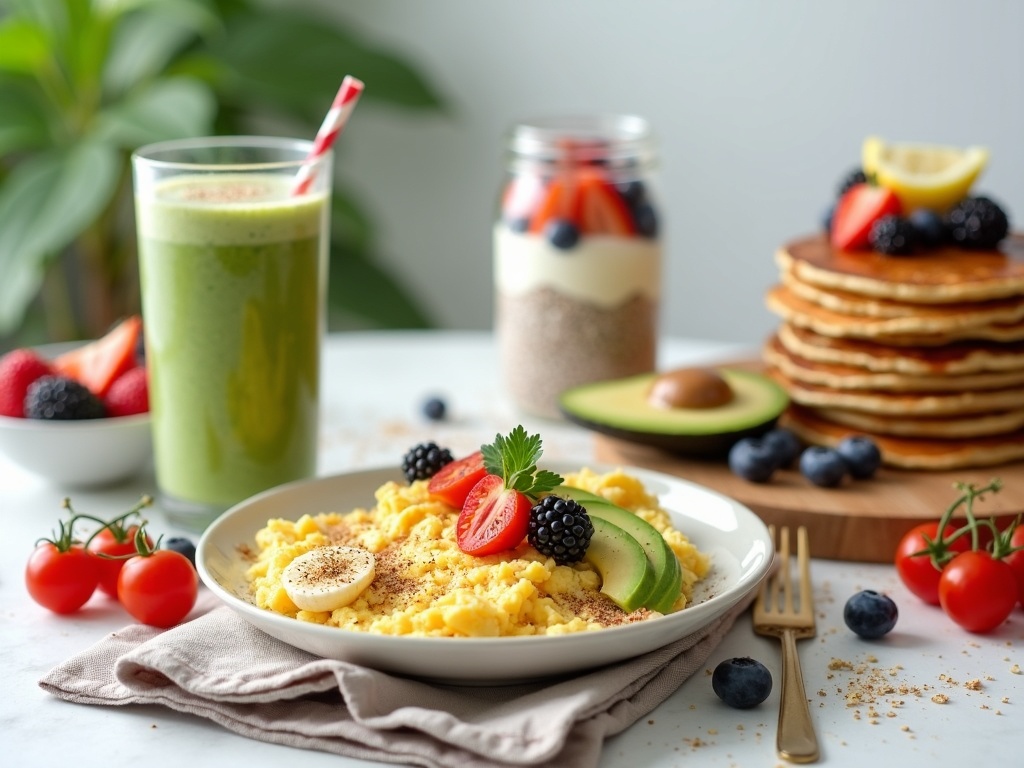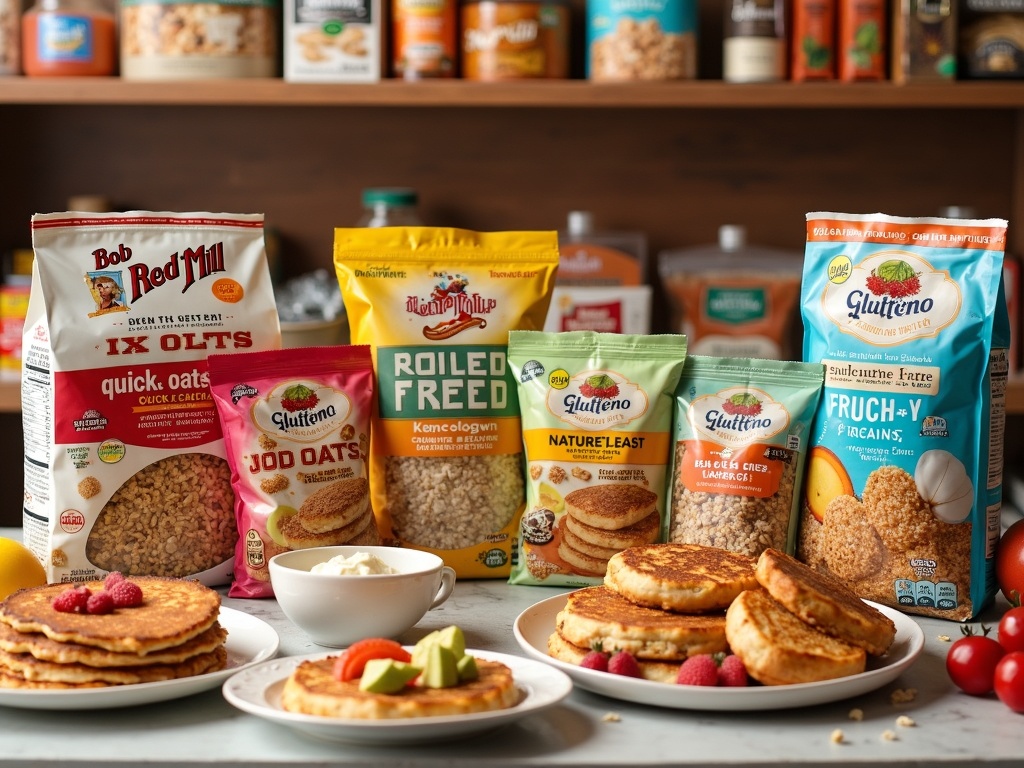The gluten free breakfast landscape has expanded dramatically, with 30% of Americans now incorporating gluten-free options into their diet despite only 1 in 133 having celiac disease. This shift has transformed what was once a medical necessity into a mainstream dietary choice with sales reaching $5 billion in 2022, driven by both health requirements and lifestyle preferences.
Find In This Article
Key Takeaways
- Naturally gluten-free breakfast options include savory oatmeal (using certified gluten-free oats), eggs, fruit-packed muesli, yogurt with toppings, and nutrient-dense smoothies.
- Smart substitutions like almond flour bread, quinoa, and brown rice can replace traditional wheat-based breakfast items while maintaining nutritional value.
- Homemade quick recipes such as four-ingredient banana pancakes, egg muffins, and overnight chia puddings offer convenient gluten-free morning solutions.
- Focusing on whole foods rather than processed alternatives ensures better nutrition in gluten-free diets, especially for maintaining adequate fiber intake.
- Trusted brands like Bob’s Red Mill, Udi’s, Nature’s Path, and Glutino provide reliable gluten-free breakfast ingredients that balance taste, texture, and safety.
Why More Americans Are Going Gluten-Free
The gluten-free movement has gained tremendous momentum in recent years. While only 1 in 133 Americans has celiac disease, a surprising 30% of Americans now actively include gluten-free foods in their diet. This dramatic shift has transformed what was once a niche health requirement into a mainstream dietary choice.
Understanding the Gluten-Free Boom
I’ve noticed a significant change in how Americans approach their morning meals. Gluten-free product sales reached an impressive $5 billion in the U.S. in 2022, reflecting both necessity and choice driving this dietary trend. This growth stems partly from increasing awareness of celiac disease and non-celiac gluten sensitivities, conditions that can cause significant digestive distress when gluten is consumed.
For those new to gluten-free eating, breakfast options might seem limited at first, but the reality is quite the opposite. Many naturally gluten-free foods make perfect morning meals:
- Savory oatmeal provides a satisfying start when using certified gluten-free oats
- Eggs prepared any style deliver protein without gluten concerns
- Fruit-packed bircher muesli made with gluten-free oats offers convenience and nutrition
- Yogurt topped with fresh fruit and nuts creates a quick, nutritious option
- Smoothies blended with fruits, vegetables, and gluten-free protein sources fuel your morning
The versatility of these options makes gluten-free baked oats and other breakfast alternatives appealing even to those without dietary restrictions. I’ve found that many people report feeling better after reducing gluten, though it’s important to note that this isn’t universal.
For those who miss traditional breakfast favorites, gluten-free versions of classics like French toast and quick pancake recipes can be created using gluten-free breads and flour blends. These alternatives have improved dramatically in taste and texture over the years.
The gluten-free trend also reflects broader food consciousness, with consumers paying closer attention to ingredients, production methods, and how different foods affect their bodies. Whether adopted by necessity or choice, gluten-free breakfasts have secured a permanent place at America’s morning table.
Smart Swaps for Your Morning Meal
Starting my day with a gluten-free breakfast doesn’t mean sacrificing taste or nutrition. I’ve discovered plenty of delicious alternatives that keep my mornings energized and my stomach happy. The key is making smart substitutions that maintain nutritional value while avoiding gluten.
Traditional breakfast staples like wheat toast, regular oatmeal, and pancakes made with all-purpose flour contain gluten. Fortunately, the market now offers countless gluten-free versions that can be just as satisfying. For instance, instead of wheat toast, I opt for bread made from almond flour, tapioca starch, or rice flour. Rather than traditional pancakes, I make fluffy pancake recipes using gluten-free flour blends.
Nutritional Powerhouses: Gluten Free Breakfast Alternatives
When switching to gluten-free options, I pay close attention to nutritional content. Many processed gluten-free products lack the fiber and nutrients found in whole grain wheat products. Adults need between 25-38 grams of fiber daily, and breakfast is an ideal time to start meeting this requirement.
Whole grains become particularly important in gluten-free diets. I incorporate these fiber-rich options into my morning meals:
- Quinoa: This complete protein works beautifully as a savory breakfast base with vegetables and an egg
- Brown rice: Perfect for breakfast bowls topped with fruit and nuts
- Gluten-free oats: Certified gluten-free oats make fantastic baked oats or overnight muesli
I’ve found creative ways to boost fiber intake by adding fruits and vegetables to my morning meals. Adding berries, sliced apples, or bananas to gluten-free cereals instantly increases fiber content. Vegetables might seem unusual for breakfast, but spinach, avocado, and grated zucchini blend seamlessly into morning smoothies or gluten-free baked goods.
Another favorite strategy is making French toast using gluten-free bread. The egg coating adds protein while creating that classic texture I love. I top it with fresh berries for added fiber and natural sweetness.
Nut butters have become my best friend for gluten-free breakfasts. A tablespoon of almond butter adds healthy fats, protein, and a creamy texture to smoothies or spread on gluten-free toast. It helps me feel satisfied longer and provides essential nutrients.
Eggs remain one of the most versatile gluten-free breakfast options. Whether scrambled, poached, or made into an omelet with vegetables, they deliver high-quality protein without any gluten concerns. For plant-based eaters, tofu scrambles seasoned with turmeric and nutritional yeast make an excellent alternative.
Ancient grains deserve special mention in the gluten-free breakfast conversation. Amaranth, buckwheat (despite its name, it’s gluten-free), and teff all cook up similarly to oatmeal but offer unique flavors and nutritional profiles. These grains have been staples in various cultures for thousands of years before modern wheat became dominant.
I’ve learned that planning ahead makes gluten-free breakfasts much easier. Preparing overnight chia puddings, setting up a smoothie station, or making batches of gluten-free granola on weekends ensures I don’t fall back on less nutritious options when pressed for time.
By focusing on whole foods naturally free from gluten rather than processed alternatives, I maintain better nutritional balance while enjoying delicious morning meals. The fiber, protein, and micronutrients from these breakfast choices provide sustainable energy that carries me through busy mornings without the digestive discomfort that gluten causes for those with sensitivities.

Quick and Easy Recipe Ideas
Starting your day with a tasty gluten-free breakfast doesn’t need to be complex. I’ve got several simple recipes that can be prepared in minutes, perfect for busy mornings when you still want something nutritious.
Banana Pancakes That Actually Taste Good
I’ve perfected a banana pancake recipe that’s become my go-to for weekend mornings. The simplicity of these pancakes is what makes them so appealing – with just four ingredients, you can have a stack of fluffy, gluten-free goodness on your plate.
To make these pancakes, you’ll need:
- 1 cup almond flour
- 1 ripe banana (mashed)
- 2 eggs
- A pinch of salt
Mix everything together until smooth, then cook spoonfuls of batter on a medium-hot skillet for 3-5 minutes per side. The natural sweetness from the banana means you can skip the sugar entirely. These quick pancakes are incredibly versatile – top them with fresh berries, a dollop of yogurt, or a drizzle of maple syrup.
For variety throughout the week, I rotate between several other quick options:
Quinoa breakfast bowls have become a staple in my morning routine. I cook a batch of quinoa ahead of time and store it in the fridge. Each morning, I reheat a portion with a splash of almond milk, then add toppings like sliced almonds, cinnamon, and fresh fruit. It’s filling and packed with protein.
Egg muffins are perfect for meal prep. I whisk eggs with chopped vegetables like spinach, bell peppers, and onions, then bake in a muffin tin. These can be made in advance and quickly reheated for a protein-packed breakfast on the go.
Chia seed pudding has saved me on countless busy mornings. The night before, I mix chia seeds with almond milk and a touch of honey, then let it sit in the fridge overnight. By morning, it’s transformed into a creamy pudding. I love creating different flavors by adding cocoa powder, vanilla extract, or cinnamon.
Smoothie bowls topped with gluten-free granola provide a refreshing start to warm days. I blend frozen fruits with a liquid base like coconut water or almond milk until thick, then pour into a bowl and add toppings. The contrast between the smooth smoothie and crunchy granola creates a satisfying texture.
For something warm and comforting, savory oatmeal made with certified gluten-free oats hits the spot. I cook the oats with vegetable broth instead of water, then top with a fried egg, avocado slices, and a sprinkle of cheese.
Overnight muesli using gluten-free oats soaked in apple juice with grated apple and yogurt creates a no-cook breakfast that’s ready when you wake up. Add a handful of chopped nuts before serving for extra crunch.
For a treat that feels indulgent but remains gluten-free, French toast made with gluten-free bread dipped in an egg, cinnamon, and vanilla mixture then fried until golden brown is delicious. Top with fresh fruit and a light dusting of powdered sugar.
The beauty of these recipes lies in their flexibility. You can customize each with seasonal fruits, different nuts and seeds, or various spices to keep your breakfast exciting while staying gluten-free. Most importantly, these options are quick to prepare, letting you enjoy a nutritious start to your day without spending hours in the kitchen.
Power-Packed Nutrition Guide
Getting the right nutrients in my gluten-free breakfast sets the tone for my entire day. I’ve discovered that focusing on whole foods rather than processed alternatives makes a significant difference in my energy levels and overall health. Let me share my practical approach to creating nutritionally balanced morning meals that don’t contain gluten.
Crafting Nutrient-Dense Breakfast Combinations
Whole foods form the foundation of a truly nourishing gluten-free breakfast. I prioritize fresh fruits, vegetables, and quality protein sources to create meals that sustain me until lunch. These natural ingredients provide essential vitamins and minerals that processed gluten-free products often lack.
A balanced breakfast should combine protein, healthy fats, and complex carbohydrates. One of my go-to options is a spinach-banana-almond milk smoothie with a tablespoon of nut butter for staying power. This simple combination delivers antioxidants, potassium, and plant-based protein in one delicious package.
Eggs paired with avocado make another perfect morning duo. The eggs provide high-quality protein while avocado contributes heart-healthy monounsaturated fats that help me feel satisfied. I often add a side of berries for a boost of antioxidants and natural sweetness without added sugars.
Fiber deserves special attention in gluten-free eating plans. Many conventional gluten-containing breakfast foods like whole wheat toast and bran cereals are fiber powerhouses, so I need to be intentional about finding alternatives. Thankfully, nature offers plenty of gluten-free options that keep my digestive system running smoothly.
Here are my top fiber-rich additions for gluten-free breakfasts:
- Chia seeds (5g fiber per tablespoon) – I stir these into overnight bircher muesli or yogurt
- Gluten-free oats (4g fiber per half cup) – perfect for warm baked oats or savory oatmeal dishes
- Flaxseeds (2g fiber per tablespoon) – ground and sprinkled over fruit
- Berries (4-8g fiber per cup) – added to virtually any breakfast
- Quinoa (5g fiber per cup) – a protein-rich base for breakfast bowls
I’ve found that maintaining nutrient density requires some planning but doesn’t need to be complicated. Keeping a well-stocked kitchen with fresh produce, quality proteins, and gluten-free whole grains makes daily breakfast decisions much easier.
Starting my day with protein-rich options like eggs, Greek yogurt, or nut butters helps stabilize my blood sugar and provides lasting energy. When I’m craving something sweet, I make gluten-free French toast using certified gluten-free bread and serve it with fresh fruit instead of syrup.
For busy mornings, I prepare make-ahead options like overnight chia pudding or quick gluten-free pancakes that can be frozen and reheated. These time-saving strategies ensure I don’t sacrifice nutrition when pressed for time.
Rotating between different breakfast recipes keeps my morning meals interesting while ensuring I get a variety of nutrients. I aim to include at least three food groups in each breakfast – typically a protein source, fruit or vegetable, and gluten-free grain or starchy vegetable.
Color diversity on my breakfast plate serves as a simple visual indicator of nutritional variety. The more naturally colorful my meal, the more likely it contains a wide spectrum of vitamins, minerals, and protective plant compounds that support my health.
When choosing packaged gluten-free products, I read labels carefully, looking for items with short ingredient lists featuring recognizable foods rather than fillers and additives. Many gluten-free packaged foods contain extra sugar, fat, or salt to improve texture and flavor, so I use them sparingly and focus on naturally gluten-free whole foods instead.

Trusted Brands to Stock Your Pantry
Starting my day with a gluten-free breakfast became so much easier once I discovered reliable brands to keep in my pantry. After years of trial and error, I’ve identified several manufacturers that consistently deliver on both taste and safety for those with gluten sensitivities.
Top Gluten-Free Breakfast Brands
Bob’s Red Mill stands as my go-to source for gluten-free oats. Their dedicated gluten-free facility means cross-contamination risks are minimized, which is crucial for those with celiac disease. I particularly love their quick-cooking oats for making savory oatmeal dishes or their rolled oats for hearty Bircher muesli. Their pancake and waffle mixes also create fluffy pancakes that don’t have that gritty texture often found in gluten-free products.
Udi’s Gluten Free has transformed my breakfast routine with their bread products. Their bagels toast beautifully and serve as the perfect base for morning egg sandwiches. Their granola makes a quick yogurt parfait possible on busy mornings, providing that satisfying crunch without any gluten concerns.
Nature’s Path offers impressive cereal and oatmeal options that don’t sacrifice flavor. Their Mesa Sunrise flakes maintain crispness in milk longer than many competitors, while their instant oatmeal packets come in various flavors perfect for baked oats recipes. For something special on weekends, their gluten-free French toast recipe using their cinnamon raisin bread is absolutely delicious.
Glutino rounds out my pantry with their breakfast bars and crackers. Their toaster pastries satisfy my occasional sweet breakfast cravings, while their table crackers provide a neutral base for savory toppings like avocado or smoked salmon.
Nutrition and Taste Considerations
When comparing these products, I’ve found important nutritional differences worth noting:
- Bob’s Red Mill generally offers higher fiber content, with their steel-cut oats providing 5g of fiber per serving
- Nature’s Path products contain less added sugar than many mainstream cereals
- Udi’s bread products have improved in texture but contain more preservatives than some alternatives
- Glutino’s convenience items tend to have higher sodium levels but excel in shelf stability
In terms of taste, texture has improved dramatically across all these brands in recent years. Bob’s Red Mill and Nature’s Path lead in creating products virtually indistinguishable from traditional versions, while Udi’s has made remarkable strides in bread texture that previously challenged gluten-free bakers.
By keeping these trusted brands in my pantry, I’ve simplified my gluten-free breakfast preparation while ensuring I start each day with something truly satisfying.

Sources:
Celiac Disease Foundation: What is Celiac Disease?
Statista: U.S. gluten-free food market size from 2016 to 2022
Gluten-Free Recipes from Cooking Light
Harvard Health: Assessing gluten-free diets
Nutritional Guidelines for Americans, USDA

